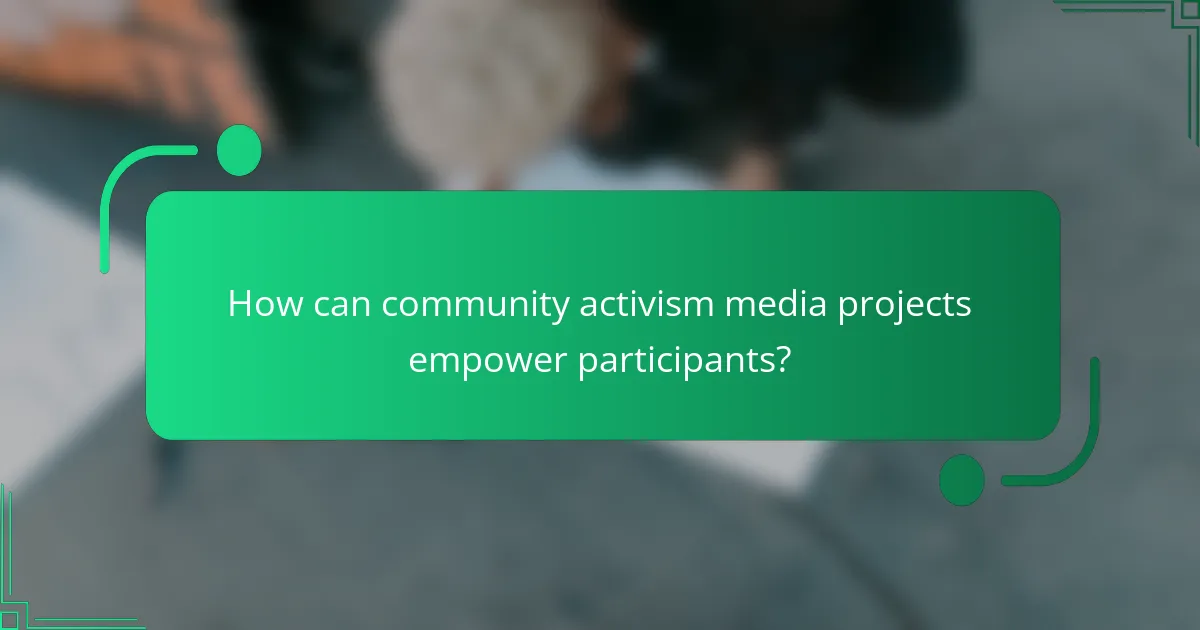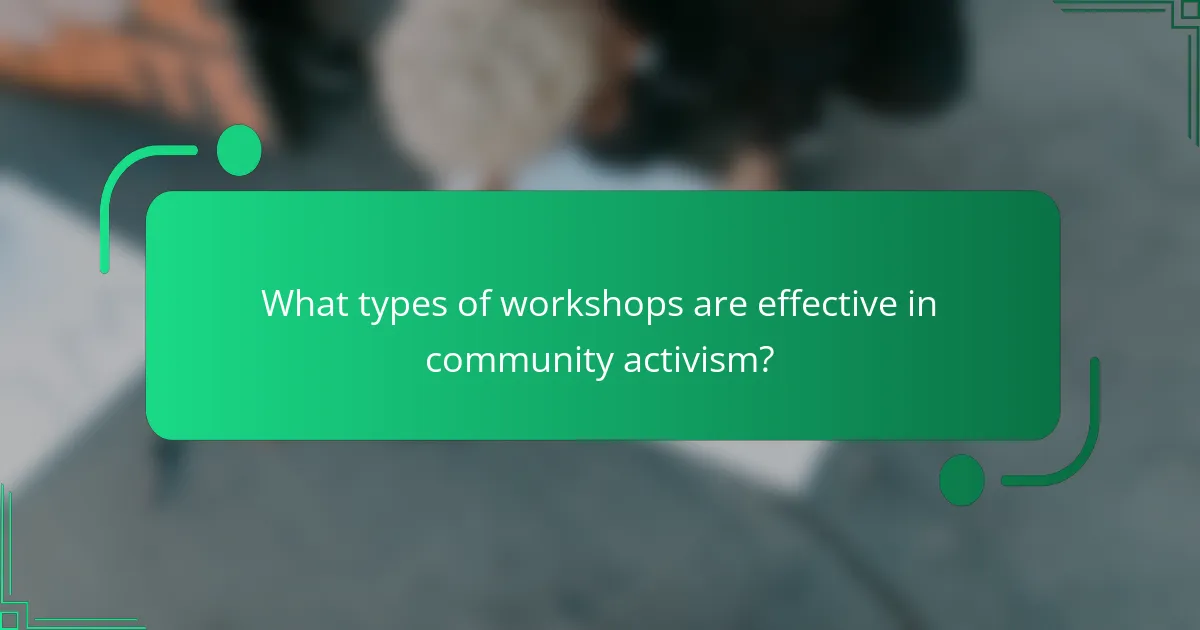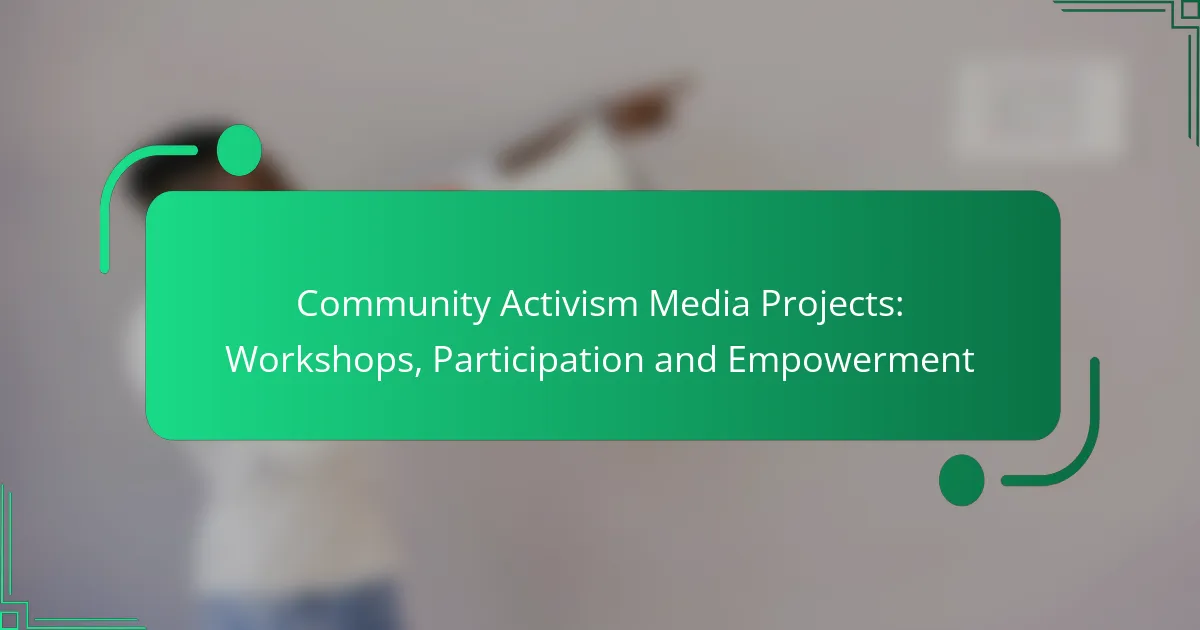Community activism media projects play a crucial role in empowering individuals by equipping them with essential skills and knowledge to drive change in their neighborhoods. Through interactive workshops that focus on media literacy and advocacy strategies, participants gain the confidence to engage actively in local issues, fostering a strong sense of ownership and collaboration within their communities.

How can community activism media projects empower participants?
Community activism media projects empower participants by providing them with the skills, knowledge, and networks needed to effect change in their communities. Through hands-on experiences, individuals gain confidence and a sense of agency, enabling them to advocate for their causes effectively.
Skill development workshops
Skill development workshops focus on teaching participants practical abilities that enhance their activism efforts. These workshops can cover areas such as media production, public speaking, and digital literacy, allowing individuals to communicate their messages more effectively.
Workshops typically range from a few hours to several days, depending on the complexity of the skills being taught. For instance, a basic media production workshop might last one day, while a comprehensive public speaking course could extend over several weeks.
Collaborative storytelling initiatives
Collaborative storytelling initiatives encourage participants to share their experiences and perspectives, fostering a sense of community and shared purpose. By working together to create narratives, individuals can amplify their voices and highlight important issues within their communities.
These initiatives often involve group discussions, interviews, and multimedia projects, allowing participants to express themselves creatively. For example, a community might produce a short documentary that showcases local challenges and triumphs, engaging a wider audience.
Local advocacy training
Local advocacy training equips participants with the tools and strategies needed to influence policy and decision-making at the community level. This training often includes understanding local governance, effective lobbying techniques, and how to mobilize support for specific causes.
Participants can expect to learn about the legislative process, how to engage with local officials, and the importance of building coalitions. Training sessions may be conducted over several weeks, with practical exercises to reinforce learning.
Networking opportunities
Networking opportunities are crucial for participants to connect with like-minded individuals, organizations, and potential allies. These connections can lead to collaborations, resource sharing, and increased visibility for their causes.
Events such as community forums, workshops, and social gatherings provide platforms for networking. Participants should actively engage in these events, exchanging contact information and following up with new connections to build lasting relationships.
Resource sharing platforms
Resource sharing platforms facilitate the exchange of tools, information, and support among community activists. These platforms can include online forums, social media groups, or local resource centers that provide access to materials and expertise.
Participants can benefit from shared resources such as templates for advocacy letters, guides on media engagement, or lists of funding opportunities. Utilizing these platforms effectively requires active participation and a willingness to contribute resources back to the community.

What types of workshops are effective in community activism?
Effective workshops in community activism focus on empowering participants with skills and knowledge to engage actively in their communities. These workshops often emphasize media literacy, digital storytelling, and social media strategies to enhance communication and advocacy efforts.
Media literacy workshops
Media literacy workshops teach participants how to critically analyze media messages and understand the role of media in shaping public perception. These sessions typically cover topics such as identifying bias, evaluating sources, and recognizing misinformation.
To conduct a successful media literacy workshop, facilitators should include interactive activities like group discussions and hands-on exercises. Participants can practice analyzing news articles or advertisements, which helps them apply their learning in real-world contexts.
Digital storytelling workshops
Digital storytelling workshops empower individuals to share their personal narratives through multimedia formats. Participants learn to create compelling stories using video, audio, and images, which can be powerful tools for advocacy and community engagement.
Facilitators should guide participants through the process of story development, including brainstorming, scripting, and editing. Providing access to basic editing software and equipment can enhance the learning experience, allowing participants to produce high-quality stories that resonate with their audience.
Social media strategy sessions
Social media strategy sessions focus on equipping community activists with the skills to effectively use social media platforms for outreach and engagement. These sessions cover best practices for content creation, audience targeting, and measuring impact.
To maximize effectiveness, workshops should include practical exercises where participants create sample posts or campaigns. Emphasizing the importance of consistency and authenticity in messaging can help participants build a strong online presence that supports their activism goals.

How does participation enhance community activism?
Participation enhances community activism by empowering individuals to take an active role in local issues, fostering a sense of ownership and responsibility. Engaged community members are more likely to advocate for change, collaborate on solutions, and support one another in their efforts.
Increased engagement in local issues
When community members participate in activism, they become more informed about local issues, which leads to greater engagement. This involvement can take various forms, such as attending town hall meetings, joining local advocacy groups, or volunteering for community projects.
For example, a neighborhood cleanup initiative not only addresses environmental concerns but also encourages residents to discuss related issues like waste management and urban planning. This collective action can significantly influence local policies and priorities.
Building community resilience
Participation in activism helps build community resilience by fostering connections among residents. Strong social networks enable communities to better respond to challenges, such as economic downturns or natural disasters.
Communities that engage in regular activism often develop shared resources, like tool libraries or mutual aid networks, which can provide support during tough times. This proactive approach strengthens the community’s ability to adapt and thrive.
Fostering diverse voices
Active participation in community activism ensures that diverse voices are heard and represented. This inclusivity is crucial for addressing the unique needs and perspectives of various groups within the community.
For instance, organizing workshops that invite input from marginalized populations can lead to more equitable solutions to local issues. By amplifying these voices, communities can create a more comprehensive and effective approach to activism that reflects the interests of all residents.

What are the key criteria for successful media projects?
Successful media projects are defined by their ability to achieve clear objectives, foster inclusivity, and implement effective communication strategies. These criteria ensure that the projects resonate with the community and empower participants through meaningful engagement.
Clear objectives and goals
Establishing clear objectives and goals is essential for guiding media projects. These objectives should be specific, measurable, achievable, relevant, and time-bound (SMART), allowing teams to track progress and evaluate success. For example, a project might aim to increase community awareness of local issues by 30% within six months.
When setting goals, consider the needs and interests of the community. Engaging stakeholders in the goal-setting process can enhance ownership and commitment, leading to more effective outcomes. Regularly revisiting and adjusting these goals based on feedback can also help maintain relevance.
Inclusivity and accessibility
Inclusivity and accessibility are crucial for ensuring that media projects engage a diverse range of participants. This involves considering various demographics, including age, socioeconomic status, and language proficiency. Providing materials in multiple languages or formats can help reach broader audiences.
Accessibility also means creating environments where everyone feels welcome to participate. This might include hosting events in physically accessible locations or using technology that accommodates individuals with disabilities. Striving for inclusivity not only enriches the project but also fosters a sense of community ownership.
Effective communication strategies
Effective communication strategies are vital for conveying messages clearly and engaging participants. Utilizing a mix of channels—such as social media, newsletters, and community meetings—can maximize outreach and ensure that information reaches various segments of the community. Tailoring messages to suit different audiences can enhance understanding and participation.
Additionally, feedback mechanisms should be established to encourage dialogue and gauge the effectiveness of communication efforts. Regularly assessing these strategies allows for adjustments that can improve engagement and impact. Consider using surveys or informal discussions to gather insights from participants about their preferences and experiences.

How can communities measure the impact of activism media projects?
Communities can measure the impact of activism media projects through various qualitative and quantitative methods. These methods include surveys, social media engagement metrics, and community feedback sessions, which help assess changes in awareness, participation, and empowerment levels.
Surveys and Feedback Mechanisms
Surveys are a direct way to gather data on community perceptions and the effectiveness of activism media projects. They can include questions about awareness of issues, perceived changes in community dynamics, and the overall impact of the project. Feedback mechanisms, such as focus groups or community meetings, can provide deeper insights into personal experiences and suggestions for improvement.
Social Media Analytics
Social media analytics can offer valuable insights into the reach and engagement of activism media projects. Metrics such as likes, shares, comments, and follower growth can indicate how well the project resonates with the community. Tools like Google Analytics or social media platforms’ built-in analytics can help track these metrics over time.
Participation Rates
Tracking participation rates in events or workshops associated with activism media projects is crucial for measuring impact. Higher attendance at events often reflects increased community interest and engagement. Communities can compare participation rates before and after project implementation to gauge effectiveness.
Case Studies and Success Stories
Documenting case studies and success stories can illustrate the tangible impacts of activism media projects. These narratives can highlight individual or collective transformations resulting from the project, showcasing how media initiatives have empowered community members. Sharing these stories can also inspire others to engage in similar activism efforts.
